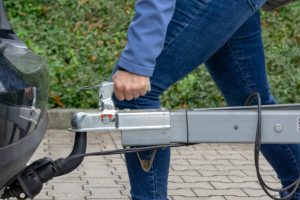Types Of Towing Hitches

Typically, there are several types of towing hitches. There is a specific trailer weight for each class. The type of hitch to choose will depend on the carrying capacity of the towed vehicles. The loaded weight of the trailer being towed must be less than the weight rating of the hitch in order to choose a more suitable hitch. The most common hitch is the receiver hitch. Its design enables mounting to the towing vehicle’s frame and provides a tube aperture for inserts of any kind, including the shank of a ball mount.
The receiver hitches are vehicle-specific, and each one is specially made for various car models. Receiver hitches are typically divided into five classes based on their weight capacities and tube sizes.
Category 1 Towing Hitch
They are often intended for small crossovers and passenger vehicles. Instead of a ball mount directly, they have a “1 14 by 1 14” receiver tube aperture or a tongue fitted to install a ball trailer. Class 1 hitches can pull trailers weighing up to 2,000 lbs. The maximum weight that a vehicle can tow, however, is not increased by using a hitch because not all have the same capacity. They are fastened to the truck pan, bumper, or frame of the vehicle.
Category 2 Towing Hitch
They are designed for towing light-weight applications and have the same tube opening size as class 1 receiver hitches. Class 2 towing Surrey can carry 3,500 pounds of gross trailer weight, which makes them different from class 1 trailers. The towing capability of a hitch cannot be increased by a higher-class drawbar. Minivans, compact cars, crossovers, pickup trucks, and compact SUVs all have them. The hitches are often fastened to the bumper or the frame of the car.
Class 3
They can support 8,000 lbs. of weight. It features a receiver tube opening that is “2 by 2.” This class of hitches solely attaches to the vehicle’s frame. It’s one of the most widely used and may be seen on full-size pickup trucks and SUVs. Class 3 hitches, which have a weight capability of 12,000 lbs. when combined with the system weight distribution, are employed in contrast to the first two classes.
Class 4
These are typically mounted on full-size pickup trucks and SUVs. They can support 10,000 lbs of weight and have a two-by-two receiver tube opening. A weight distribution system is necessary, and they can also employ a trailer with a gross weight capacity of 14,000 pounds. Only the frame of the car is connected to the hitches.
Class 5
When it comes to weight, they receive the best marks. They are designed to support heavy loads. However, a weight-distributing hitch can level the trailer while towing a car. Commercial trucks and full-size pickups can also use them. They have a 12,000-pound weight capacity, and the tongue weight of the trailer cannot exceed 1200 lbs. Only the frame of the car is connected to its hitches.

 Tips To Improve Fuel Efficiency
Tips To Improve Fuel Efficiency